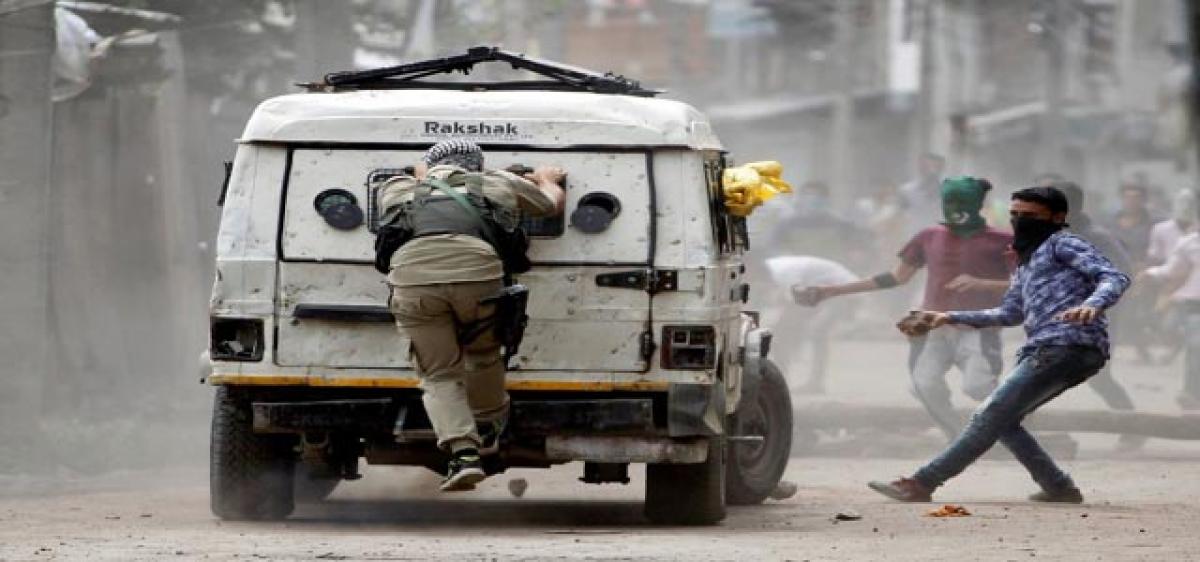Live
- First TGCHE, V-Cs meet deliberates on higher education roadmap for state
- 2 senior professors to join NALSAR
- Former Principal of SPW College passes away in US
- Hyderabad: Govt out to remove electric poles, transformers on roads across city
- KCR goes into huddle with State legal eagles
- Formula E race: KTR to be arrested soon?
- Film fraternity stands with Allu Arjun
- New CUAP campus faces security challenges
- HC grants protection to Allu Arjun from arrest
- Stampede victim’s husband ready to withdraw case against Allu Arjun
Just In

Simmering anger over India\'s crackdown on 10 weeks of protests in Kashmir risks drawing more young people to radical rebellion, demonstrators and security officials warn, as the sense of despair and alienation from New Delhi deepens.
Srinagar : Simmering anger over India's crackdown on 10 weeks of protests in Kashmir risks drawing more young people to radical rebellion, demonstrators and security officials warn, as the sense of despair and alienation from New Delhi deepens. In the worst unrest in the disputed Himalayan region for six years, more than 80 civilians have been killed and thousands wounded, a widespread curfew is in place and suspected ringleaders are being held without charge.
"They are treating us like 'dons', like we are criminals," said Bilal Bhat, a 27-year-old journalist who is active in a local youth civil rights movement. Bhat was taken in by police in August and told to stop posting articles on Facebook. It was the second time he has been held. "When I was beaten by the cop, I cursed myself for taking a pen - I should have taken a gun instead," he told Reuters.
A conflict that has seeped for decades and spilled into war twice between nuclear-armed rivals India and Pakistan usually passes little noticed by the international community. India's security forces have also reinforced their already large presence in Kashmir, drafting in 20,000 paramilitaries and 10,000 more soldiers. A senior Home Ministry official said India's security forces had reduced their use of pellet ammunition, which has drawn widespread condemnation, and had been instructed only to fire when they felt directly threatened.
India blames Pakistan for a raid earlier in September on a base that killed 18 soldiers, in the deadliest attack on its army in 14 years, prompting Hindu nationalist supporters of Prime Minister Narendra Modi's government to call for revenge. Several countries, alarmed at the prospect of a military response by India, condemned the attack, while Pakistan denied any involvement.
Journalist Bhat and others see the start of the latest crisis in Kashmir not as the attack on the army camp in Uri on September 18, but the killing by Indian security forces of Burhan Wani, a popular separatist militant leader, on July 8. Many of those killed in the clashes died from shotgun pellets or rifle bullets fired by police and paramilitary troops, and the supposedly non-lethal pellet rounds have blinded hundreds of bystanders, including children and women.
The ophthalmology ward of Srinagar's main SMHS hospital is still overflowing with patients either partly or fully blinded by pellet rounds fired by police or paramilitary troops. The 850-bed hospital has received hundreds of casualties from street clashes, which have died down for now.
Schools in Srinagar have been commandeered and turned into barracks and, even in quieter parts of the city of 1.3 million where the curfew has been lifted, there is a heavy security presence. Most shops remain shut. In the meantime, the protests have given a new lease of life to militants who have been sighted among the crowds and are believed by the authorities to be playing an active role in organising them.
"It's a very organised hoodlum element that works with the militants," said a senior police officer with long experience of the insurgency in Kashmir that first broke out at the end of the 1980s. The officer pulled a smartphone out of his pocket and showed a video circulated by Zakir Rashid Bhat, named to replace Wani as Hizbul Mujahideen's commander in South Kashmir.
The video shows men in uniform beating protesters and is accompanied by a soundtrack of rhythmic chants urging people to be faithful and to take revenge against the police. "This is the imagery of ISIS," the police officer said, referring to the extremist group Islamic State. "The radicalisation is growing stronger."
By Douglas Busvine & Fayaz Bukhari

© 2024 Hyderabad Media House Limited/The Hans India. All rights reserved. Powered by hocalwire.com







